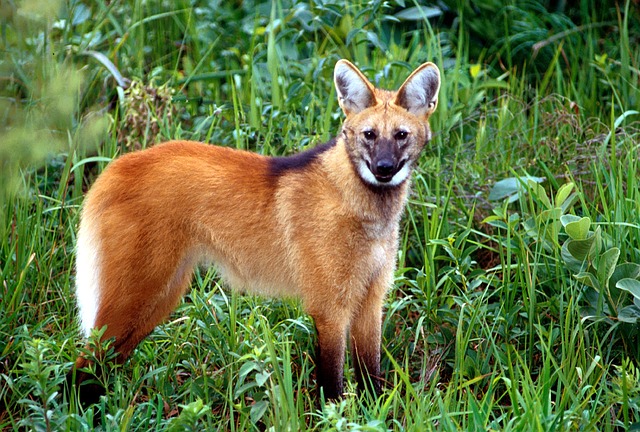The maned wolf (Chrysosyon brachyurus) stands out as a unique and captivating figure in the vast biodiversity of South America. Famous for its distinctive appearance, mysterious behavior, and vital role in its ecosystem, this solitary canid has attracted researchers and wildlife enthusiasts alike. Let's delve deeper into the world of the maned wolf, exploring its habitat, characteristics, behavior and the conservation challenges it faces.
Habitat and area:
Endemic to South America, the maned wolf primarily inhabits the grasslands, savannas and shrublands of Brazil, Paraguay, Argentina and Bolivia. Unlike its more forest-dwelling relatives, the maned wolf prefers open habitats, where its long legs and distinctive rust-colored fur provide effective camouflage among tall grasses.
Physical Characteristics:
The most distinctive feature of the maned wolf is its distinctive mane, which runs down the back of its neck and shoulders. Despite their wolf-like appearance, the maned wolf is not closely related to true wolves. Standing about 3 feet tall at the shoulder, it is the largest canid in South America. Its slender legs and tall stature are adapted for hunting in grasslands, allowing it to navigate vegetation and spot prey.
Behavior and diet:
Maned wolves are primarily crepuscular, meaning they are most active during dawn and dusk. Their diet is diverse, including small mammals, birds, fruits and vegetation. They are known for their unique hunting technique, which involves standing on their hind legs to get a better view of their surroundings.
Despite their somewhat solitary nature, maned wolves establish and defend territories using scent markings to communicate with each other. Interestingly, they are not known to form herds like their distant relatives. Instead, they are often seen alone or in pairs, especially during the breeding season.
Conservation Challenges:
The maned wolf faces several threats to its survival, making it a subject of concern for conservationists. Habitat loss due to agricultural expansion, human settlement and infrastructure development is a significant threat. Additionally, road accidents and diseases spread by domestic dogs pose a threat to their population.
Conservation efforts focus on protecting and restoring their natural habitats, establishing wildlife corridors, and raising awareness about the importance of co-existing with these mysterious creatures. Captive breeding programs also play a role in preserving genetic diversity and providing a potential safety net for the species.
The maned wolf, with his adorable appearance and unique behavior, stands as a symbol of the diverse and delicate ecosystems of South America. As we strive to preserve this remarkable species, it serves as a reminder of the interconnectedness of all living beings and the importance of preserving the biodiversity that enriches our planet. In understanding and protecting the maned wolf, we contribute to a broader spectrum of life, ensuring that future generations can continue to marvel at the wonders of the natural world.
Maned wolf facts
Typical Appearance:
The maned wolf (Chrysosyon brachyurus) is easily recognized by its long legs, slender body and distinctive reddish-brown fur. The most distinctive feature is its long, dark mane, which runs down to the back of its neck and shoulders.
Tallest canid in South America:
Standing at an impressive height of approximately 3 feet at the shoulder, the maned wolf is the largest canid species in South America. Despite its wolf-like appearance, it is not closely related to actual wolves.
Habitat and area:
Native to South America, the maned wolf primarily inhabits grasslands, savannas, and shrublands. Its range includes countries like Brazil, Paraguay, Argentina and Bolivia.
Crepuscular behavior:
Maned wolves are primarily crepuscular, meaning they are most active at dawn and dusk. This behavior helps them survive the intense heat of the day and survive more effectively in their grasslands.
Unique Hunting Techniques:
The maned wolf has a unique hunting style. It stands on its hind legs to gain a better vantage point, allowing it to peer through tall grasses and spot prey. This behavior is often called "stilts" or "high-standing".
Varied diet:
The diet of the maned wolf is diverse, including small mammals, birds, fruits, and vegetation. This omnivorous approach to food contributes to its adaptability to different environments.
Solitary Nature:
Unlike some other canid species, maned wolves often live alone or are found in pairs, especially during the breeding season. They establish and defend territories using scent markings to communicate with other wolves.
Conservation Concerns:
The maned wolf faces several threats, with habitat loss being a major concern. Human activities such as agriculture, urbanization and infrastructure development contribute to the shrinkage of their natural habitats. Road accidents and diseases spread by domestic dogs also pose threats to their population.
Conservation efforts:
Conservation initiatives focus on protecting and restoring the maned wolf's natural habitats. Wildlife corridors have been established to connect fragmented areas, and educational programs aim to raise awareness of the importance of co-existing with these unique creatures. Captive breeding programs exist to ensure genetic diversity and provide a safety net for the species.
Role in Ecosystem:
As apex predators in their ecosystems, maned wolves play an important role in controlling populations of prey species. By maintaining balance in the food chain, they contribute to the overall health and stability of the ecosystem in which they live.



Comments
Post a Comment